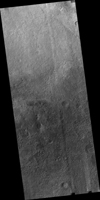
Map Projected Browse Image
Click on the image for larger versionDespite the recent successes of missions landing on Mars, like the Mars Science Laboratory (Curiosity) or the arrival of new satellites, such as India's MOM orbiter, the Red Planet is also a graveyard of failed missions.
The Soviet Mars 2 lander was the first man-made object to touch the surface of the Red Planet when it crashed landed on 27 November 1971. It is believed that the descent stage malfunctioned after the lander entered the atmosphere at too steep an angle. Attempts to contact the probe after the crash were unsuccessful.
HiRISE acquired this image to aid in the search for the missing lander. If the Mars 2 debris field is found, it could serve as a future landing location for a mission to study the effects of crash landing on the Martian surface and effects of aging on man-made objects.
This caption is based on the original science rationale. To date, the debris field has not been located, but this spot was noted as a probably location for the Mars 3 lander.
HiRISE is one of six instruments on NASA's Mars Reconnaissance Orbiter. The University of Arizona, Tucson, operates HiRISE, which was built by Ball Aerospace & Technologies Corp., Boulder, Colorado. NASA's Jet Propulsion Laboratory, a division of the California Institute of Technology in Pasadena, manages the Mars Reconnaissance Orbiter Project for NASA's Science Mission Directorate, Washington.

